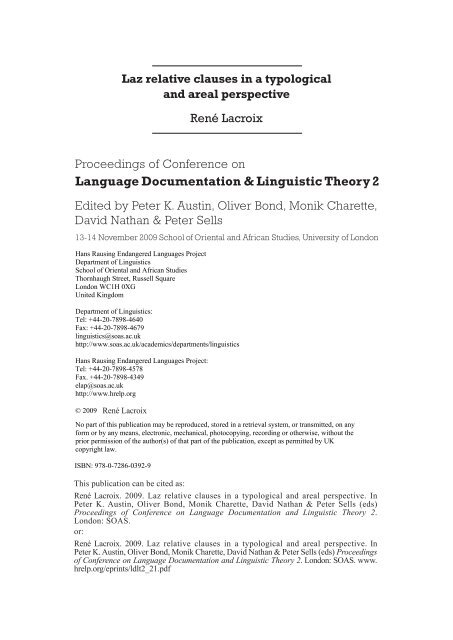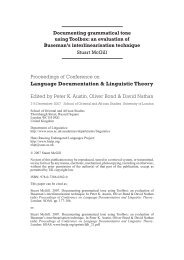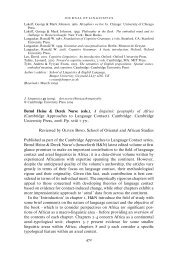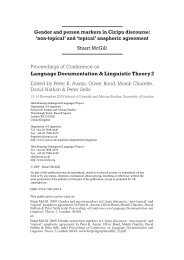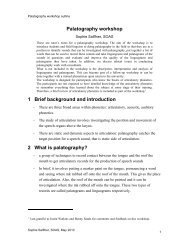Language Documentation & Linguistic Theory 2 - Hans Rausing ...
Language Documentation & Linguistic Theory 2 - Hans Rausing ...
Language Documentation & Linguistic Theory 2 - Hans Rausing ...
You also want an ePaper? Increase the reach of your titles
YUMPU automatically turns print PDFs into web optimized ePapers that Google loves.
Laz relative clauses in a typological<br />
and areal perspective<br />
René Lacroix<br />
Proceedings of Conference on<br />
<strong>Language</strong> <strong>Documentation</strong> & <strong>Linguistic</strong> <strong>Theory</strong> 2<br />
Edited by Peter K. Austin, Oliver Bond, Monik Charette,<br />
<strong>Hans</strong> <strong>Rausing</strong> Endangered <strong>Language</strong>s Project<br />
Department David <strong>Hans</strong> <strong>Rausing</strong> of Nathan Endangered <strong>Linguistic</strong>s & <strong>Language</strong>s Peter Project Sells<br />
School Department of Oriental of <strong>Linguistic</strong>s and African Studies<br />
Thornhaugh 13-14 School of November Oriental Street, and Russell 2009 African Square School Studies of Oriental and African Studies, University of London<br />
London Thornhaugh WC1H Street, 0XG Russell Square<br />
United <strong>Hans</strong> London <strong>Rausing</strong> Kingdom WC1H Endangered 0XG <strong>Language</strong>s Project<br />
Department United Kingdom of <strong>Linguistic</strong>s<br />
Department School of Oriental of <strong>Linguistic</strong>s: and African Studies<br />
Tel: Thornhaugh Department +44-20-7898-4640 of Street, <strong>Linguistic</strong>s: Russell Square<br />
Fax: London Tel: +44-20-7898-4640<br />
+44-20-7898-4679<br />
WC1H 0XG<br />
linguistics@soas.ac.uk<br />
United Fax: +44-20-7898-4679<br />
Kingdom<br />
http://www.soas.ac.uk/academics/departments/linguistics<br />
linguistics@soas.ac.uk<br />
Department http://www.soas.ac.uk/academics/departments/linguistics<br />
of <strong>Linguistic</strong>s:<br />
<strong>Hans</strong> Tel: +44-20-7898-4640<br />
<strong>Rausing</strong> Endangered <strong>Language</strong>s Project:<br />
Tel: Fax: <strong>Hans</strong> +44-20-7898-4578<br />
+44-20-7898-4679<br />
<strong>Rausing</strong> Endangered <strong>Language</strong>s Project:<br />
Fax. linguistics@soas.ac.uk<br />
Tel: +44-20-7898-4578<br />
+44-20-7898-4349<br />
elap@soas.ac.uk<br />
http://www.soas.ac.uk/academics/departments/linguistics<br />
Fax. +44-20-7898-4349<br />
http://www.hrelp.org<br />
elap@soas.ac.uk<br />
<strong>Hans</strong> http://www.hrelp.org<br />
<strong>Rausing</strong> Endangered <strong>Language</strong>s Project:<br />
Tel: +44-20-7898-4578<br />
Fax. +44-20-7898-4349<br />
elap@soas.ac.uk<br />
http://www.hrelp.org<br />
© 2009 The Authors<br />
© 2009 The René Authors Lacroix<br />
No part of this publication may be reproduced, stored in a retrieval system, or transmitted, on any<br />
form No part or by of this any publication means, electronic, may be mechanical, reproduced, photocopying, stored in a retrieval recording system, or otherwise, or transmitted, without on the any<br />
prior form permission or by any means, of the electronic, author(s) of mechanical, that part of photocopying, the publication, recording except as or permitted otherwise, by without UK the<br />
copyright © prior 2009 permission The law. Authors of the author(s) of that part of the publication, except as permitted by UK<br />
copyright law.<br />
No part of this publication may be reproduced, stored in a retrieval system, or transmitted, on any<br />
ISBN: form or 978-0-7286-0392-9<br />
by any means, electronic, mechanical, photocopying, recording or otherwise, without the<br />
prior ISBN: permission 978-0-7286-0392-9 of the author(s) of that part of the publication, except as permitted by UK<br />
copyright law.<br />
This publication can be cited as:<br />
Printed in the United Kingdom<br />
René Lacroix. 2009. Laz relative clauses in a typological and areal perspective. In<br />
Printed in the United Kingdom<br />
Peter ISBN: 978-0-7286-0392-9<br />
K. Austin, Oliver Bond, Monik Charette, David Nathan & Peter Sells (eds)<br />
Proceedings of Conference on <strong>Language</strong> <strong>Documentation</strong> and <strong>Linguistic</strong> <strong>Theory</strong> 2.<br />
London: SOAS.<br />
or: Printed in the United Kingdom<br />
René Lacroix. 2009. Laz relative clauses in a typological and areal perspective. In<br />
Peter K. Austin, Oliver Bond, Monik Charette, David Nathan & Peter Sells (eds) Proceedings<br />
of Conference on <strong>Language</strong> <strong>Documentation</strong> and <strong>Linguistic</strong> <strong>Theory</strong> 2. London: SOAS. www.<br />
hrelp.org/eprints/ldlt2_21.pdf
Laz relative clauses in a typological and areal perspective<br />
RENÉ LACROIX<br />
Laboratoire Dynamique du Langage, Lyon<br />
1. INTRODUCTION<br />
This paper examines the relativization strategies of Laz (South Caucasian) in a<br />
typological and areal perspective 1 .<br />
Laz is an underdescribed and endangered language spoken in North-East<br />
Turkey. The last official Turkish census dates back to 1965 and gives the number<br />
of 85,108 speakers (Andrews 1989: 176). Feurstein (1983) estimates 250,000<br />
speakers. All Laz are bilingual with Turkish. Young people under the age of 25<br />
still understand, but do not speak Laz. Laz is not written and is only spoken within<br />
the close family circle.<br />
There are four main dialects. The data presented here, from the Arhavi dialect,<br />
are taken from published sources and from material which I gathered during field<br />
trips. The data and the analysis of other languages are taken primarily from<br />
Creissels (2005).<br />
In this paper, I adopt the definition of relativization used in works such as<br />
Keenan and Comrie (1977), Keenan (1985), Comrie (1989), Creissels (2006) and<br />
Andrews (2007). Andrews’ definition may be cited here: ‘A relative clause (RC) is<br />
a subordinate clause which delimits the reference of an NP by specifying the role<br />
of the referent of that NP in the situation described by the RC’ (2007: 206).<br />
Almost all types of relativization strategies are attested in the Caucasus-Iran-<br />
Anatolia area (Creissels 2005). As will be seen, the main strategy of Laz differs<br />
both from the strategies found in the other South Caucasian languages and from<br />
Turkish, with which it is in contact. In what follows, I examine prenominal<br />
relatives (section 2), postnominal relatives (section 3) and correlatives (section 4).<br />
2. PRENOMINAL RELATIVE CLAUSES<br />
2.1. Areal data<br />
Prenominal relatives using participles are widespread in the Caucasus-Iran-<br />
Anatolia area. In particular, they represent the most productive strategy in Turkic<br />
1 In the transcription of Laz, the apostrophe marks glottalized consonants. The following<br />
abbreviations are used: AOR = aorist, APPL = applicative, COP = copula, DAT = dative, DEF =<br />
definite, DEM = demonstrative, DIST = distal, ERG = ergative, FUT = future, IMP = imperative,<br />
INT/REL = interrogative/relative pronoun, JCT = junctor, MID = middle, NEG = negation, NHS = nonhuman<br />
singular, OPT = optative, PL = plural, POSS = possessive, PRES = present, PTCP = participle,<br />
PV = preverb, REL = relativizer, SUB = subordinator, TAM = tense-aspect-mood, THS = thematic<br />
suffix, TR = transitive. Roman figures (I and II) indicate the set of cross-referencing affixes. For<br />
instance, I1 = Set I, 1 st person; II2 = Set II, 2 nd person.<br />
205
LANGUAGE DOCUMENTATION AND LINGUISTIC THEORY 2<br />
and North-East Caucasian languages. Here is an example from Godoberi. The<br />
same participle is used to relativize different syntactic roles: the A argument in<br />
(1b) and the O argument in (1c).<br />
(1) (a) wacu-di hamaχi b-aχi<br />
brother-ERG donkey NHS-buy.PAST<br />
‘My brother bought the donkey.’<br />
(b) hamaχi b-aχi-bu waci<br />
donkey NHS-buy.PAST-PTCP brother<br />
‘my brother who bought the donkey’<br />
(c) wacu-di b-aχi-bu hamaχi<br />
brother-ERG NHS-buy.PAST-PTCP donkey<br />
‘the donkey that my brother bought’<br />
(Creissels 2005: 8)<br />
Turkish also uses prenominal relative clauses with non finite verbs.<br />
In the Indo-European languages of the area, it is not rare to find prenominal<br />
participial relatives beside postnominal ones. Western Armenian is a case in point:<br />
(2) (a) (ayn) mardə or P’ariz ekaw<br />
(DEM) man.DEF REL Paris come.TAM.3SG<br />
‘the man who came to Paris’<br />
(b) P’ariz ekoɣ mardə<br />
Paris come.PTCP man<br />
‘the man who came to Paris’<br />
(Creissels 2005: 9)<br />
Contrary to what is found in Turkic and North-East Caucasian languages, Indo-<br />
European participial relatives are often more restricted as to which role can be<br />
relativized; often, only the subject can.<br />
2.2. Laz<br />
Laz has several types of relative clauses. In one of the most productive strategies,<br />
the relative precedes the head. The verb is finite and occurs at the end of the<br />
relative clause. If the verb is the only constituent of the relative clause, the clitic<br />
subordinator na prefixes to it:<br />
(3) (a) na-p’-or-om bozo b-dzi-i<br />
SUB-I1-love-THS girl I1-see-AOR<br />
‘I saw the girl I love.’<br />
(own field data)<br />
206
RENÉ LACROIX<br />
By ‘finite verb’, I intend a verb which has the ability to head an independent<br />
clause. The verb form p’orom ‘I love’ in (3a), for instance, can be used in an<br />
independent clause, as illustrated by (3b) below.<br />
(b) he bozo-s p’-or-om<br />
DIST.DEM girl-DAT I1-love-THS<br />
‘I love that girl.’<br />
(K’art’ozia 1972, text 139)<br />
If the relative clause includes other words before the verb, the subordinator na is<br />
suffixed to one of them:<br />
(4) bee-k bozo-s-na me-č-u matsk’indi čxant’-u-n<br />
child-ERG girl-DAT-SUB PV-give-AOR.I3SG ring shine-THS-I3SG<br />
‘The ring that the child gave to the girl shines.’<br />
(own field data)<br />
(5) ma-na ti me-m-o-k’vat-ase k’oči<br />
1SG-SUB head PV-II1-APPL-cut.off-FUT.I3SG man<br />
‘the man who will cut off my head’<br />
(K’art’ozia 1993, text 125)<br />
When asked to repeat a sentence containing na, my consultant often changes the<br />
place of the subordinator, which suggests that it is not determined by a rigid rule.<br />
Examples are found where the subordinator appears twice in the relative clause.<br />
Prenominal relative clauses using finite verb forms are typologically rare, as<br />
noted by Keenan (1985: 160).<br />
As illustrated by the examples above, Laz relative clauses use a gap strategy:<br />
the position relativized is left empty in the relative clause. The functions of<br />
intransitive subject, transitive subject, direct object, E argument 2 and oblique may<br />
be relativized.<br />
Laz free relatives can be described as canonical [relative clause + domain<br />
noun] constructions from which the domain noun would have been simply<br />
deleted. In such constructions, the suffixes which normally appear on the head<br />
noun attach to the finite verb of the relative:<br />
(6) si-na čk’om-i-pe-k va g-o-dzɣ-es-na<br />
2SG-SUB eat-AOR-PL-ERG NEG II2-TR-satisfy-AOR.I3PL-if<br />
‘If the ones you ate didn’t satisfy you...’<br />
(K’art’ozia 1972, text 137)<br />
2<br />
E stands for ‘extension to core’ (see Dixon and Aikhenvald 2000: 3). The main semantic roles<br />
associated with E arguments in Laz are beneficiary and recipient.<br />
207
LANGUAGE DOCUMENTATION AND LINGUISTIC THEORY 2<br />
Here I will also examine a typologically interesting case of free relatives being<br />
grammaticalized into topic particles.<br />
The subordinator na has a range of other functions: it appears in complement<br />
clauses, adverbial clauses and conditional clauses.<br />
There is another strategy used to form prenominal relatives, involving a<br />
participle. This participle can relativize different syntactic roles: the subject, the<br />
object and the E argument.<br />
3. POSTNOMINAL RELATIVE CLAUSES<br />
3.1. Areal data<br />
Postnominal relative clauses are attested in Georgian, Persian and Kurmanji<br />
Kurdish. Georgian uses relative pronouns. In Persian and kurmanji Kurdish<br />
(example 7), the relative is introduced by an invariable relativizer, which purely<br />
indicates subordination; in addition, resumptive pronouns are used.<br />
(7) gund-ê ku lê dimînim<br />
village-JCT SUB in.3SG stay.PRES.1SG<br />
‘the village where I live’<br />
(Creissels 2005: 5)<br />
3.2. Laz<br />
In my corpus, I have found very few examples of postnominal relative clauses.<br />
One of them is given in (8). The relative clause begins with the relative pronoun<br />
namu, whose case inflection reflects the function of the relativized constituent in<br />
the relative. The verb is finite.<br />
(8) ko-go-y-šin-es he kčini,<br />
PV-PV-MID-remember-AOR.I3PL DIST.DEM old.woman<br />
namu-k uškuri me-č-u<br />
INT/REL-ERG apple PV-give-AOR.I3SG<br />
‘They remembered the old woman who had given them the apple.’<br />
(K’art’ozia 1972, text 135)<br />
The pronoun namu is also used as an interrogative pronoun referring to a choice<br />
between a set of elements:<br />
(9) namu go-mtsk’-a?<br />
INT/REL PV-I1.open-OPT<br />
‘Which one should I open?’<br />
(Dumézil 1937, text I)<br />
Namu appears also in indirect questions and in correlative clauses (see below).<br />
208
4. CORRELATIVE CLAUSES<br />
RENÉ LACROIX<br />
4.1. Areal data<br />
In correlative clauses, the domain noun generally appears inside the relative<br />
clause, which is left-dislocated. A typologically infrequent type of correlative<br />
clause is attested in colloquial Georgian. Consider, for instance, example (10).<br />
The domain noun kali ‘woman’ appears in the main clause; the relativization is<br />
marked by the subordinator rom, which is not restricted to relative clauses. Rom<br />
gives no clue as to which role is relativized.<br />
(10) xval rom naxavt,<br />
tomorrow SUB see.FUT.2PL<br />
is kali čveni axali mezobeli-a<br />
DIST.DEM woman POSS1PL new neighbor-COP<br />
‘The woman who you will see tomorrow is our new neighbor.’<br />
(Creissels 2005: 15)<br />
Correlative clauses appear sporadically in Turkish.<br />
4.2. Laz<br />
Laz attests free relatives using the correlative clause strategy. One example is<br />
given in (11). The left-dislocated constituent namu mogts’ondasen ‘the one you<br />
like’ is coreferent with the demonstrative pronoun heya in the main clause.<br />
(11) [namu mo-g-ts’ond-asen], heya e-č’op-i!<br />
INT/REL PV-II2-like-FUT.I3SG DIST.DEM PV-take-IMP<br />
‘Take the one you like!’ (lit. ‘which one you like, take it!’)<br />
(Žɣent’i 1938, text 27)<br />
The bracketed constituent functions as a free relative. No domain noun is stated.<br />
The interrogative/relative pronoun namu, which occurs in the position relativized,<br />
can be analyzed as a ‘domain noun substitute’ (see Creissels 2006: 208).<br />
5. CONCLUSION<br />
Almost all types of relativization strategies are attested in the Caucasus-Iran-<br />
Anatolia area. The important variation found in this domain correlates to some<br />
extent with genetic distribution. Broadly speaking, Turkic and North Caucasian<br />
languages, which mainly use prenominal participial relatives, contrast with Indo-<br />
European and South-Caucasian languages, where postnominal relatives headed by<br />
finite verb forms are common. From this point of view, Laz constitutes a<br />
particular case. Its major relativization strategy involves prenominal relative<br />
clauses headed by finite verb forms, a typologically infrequent type. This strategy<br />
209
LANGUAGE DOCUMENTATION AND LINGUISTIC THEORY 2<br />
differs from those found in other South Caucasian languages, but cannot be<br />
explained by the influence of neighboring languages.<br />
REFERENCES<br />
Andrews, Avery D. 2007. Relative clauses. In: Shopen, Timothy (ed.) <strong>Language</strong><br />
Typology and Syntactic Description. Second edition. Vol. 2: Complex<br />
constructions. 206-236. Cambridge: Cambridge University Press<br />
Andrews, Peter A., compiled and edited with the assistance of Rüdiger<br />
Benninghaus. 1989. Ethnic Groups in the Republic of Turkey. Wiesbaden:<br />
Reichert<br />
Dixon, Robert M.W., Aikhenvald, Alexandra Y. (eds.) 2000. Changing Valency.<br />
Case studies in transitivity. Cambridge: Cambridge University Press<br />
Dumézil, Georges. 1937. Contes Lazes. Paris: Institut d’Ethnologie<br />
Feurstein, Wolfgang. 1983. Untersuchungen zur materiellen Kultur der Lazen.<br />
(unpubl. M.A. thesis). Freiburg<br />
Comrie, Bernard. 1989. <strong>Language</strong> Universals and <strong>Linguistic</strong> Typology. Second<br />
edition. Oxford: Basil Blackwell<br />
Creissels, Denis. 2005. Typologie de la relativisation et données de l’aire<br />
Caucase-Iran-Anatolie. Paper presented at the workshop Atelier de syntaxe<br />
arménienne, Pithiviers, France, May 23-25<br />
Creissels, Denis. 2006. Syntaxe générale: une introduction typologique. Vol. 2.<br />
Paris: Lavoisier<br />
Keenan, Edward L. 1985. Relative clauses. In: Shopen, Timothy (ed.) <strong>Language</strong><br />
Typology and Syntactic Description. Vol. 2: Complex constructions. 141-<br />
170. Cambridge: Cambridge University Press<br />
Keenan, Edward L., Comrie, Bernard. 1977. Noun phrase accessibility and<br />
universal grammar. <strong>Linguistic</strong> Inquiry 8, 63-99<br />
K’art’ozia, Guram. 1972. Lazuri t’ekst’ebi. Tbilisi: Mecniereba<br />
K’art’ozia, Guram. 1993. Lazuri t’ekst’ebi, II. Tbilisi: Mecniereba<br />
Žɣent’i, Sergi. 1938. Č’anuri t’ekst’ebi, arkabuli k’ilok’avi. Tbilisi: SSRK’<br />
Mecnierebata Ak’ademiis Sakartvelos Pilialis Gamomcemloba<br />
210


